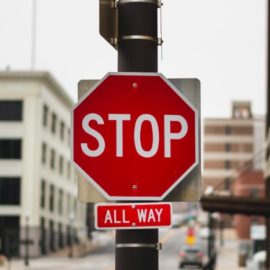

This article is an excerpt from the Shortform summary of "The Smartest Guys in the Room" by Bethany McLean and Peter Elkind. Shortform has the world's best summaries of books you should be reading.
Like this article? Sign up for a free trial here .
How did the bad Enron accounting fraud lead to the company’s failure?
Enron accounting fraud were questionable, but not necessarily illegal. But Enron accounting fraud was focused exclusively on stock price, and as a results, faced pressure to demonstrate profits when there were none. Keep reading to find out how Enron accounting fraud contributed to the company’s collapse.
How Enron Accounting Fraud Started
The failure of Enron in the early 2000’s is one of the largest bankruptcies in US history (with Lehman Brothers in 2008 as the largest). Eron accounting fraud led to Enron’s bankruptcy as well as the dissolution of Arthur Andersen, one of the big five accounting firms. Shareholders were wiped out, and tens of thousands of employees left with worthless retirement accounts.
Today the name “Enron” still evokes a reflexive repulsion, a feeling that these were simply bad people doing illegal things. But, we think, that’s in the past. Surely we’ve evolved as a society, and by thinking hard enough, you or I can avoid these problems.
In reality, when you dig into the details, Enron’s downfall is the predictable mixture of human greed, poorly structured incentives, and lack of sanity checks when everyone has their fingers in the pie.
You might be surprised to learn that most of Enron’s accounting fraud were not technically illegal at the time – they were actually publicly celebrated for being financial innovations. Shareholders, employees, investment bankers, and accountants all benefited from the situation and enabled Enron for years. They only stopped when it became untenable.
The most important takeaway from The Smartest Guys in the Room is to understand the key enabling conditions for Enron’s deception. When multiple conditions mutually reinforce each other and create positive feedback loops, a massively outsized result – a lollapalooza – can happen.
These are also the warning signs you can use to detect unstable situations and desist from bad behavior.
Skilling’s obsession with Enron’s stock price and with meeting quarterly Wall Street targets got Enron addicted to bad business practices:
- Skilling would ask analysts, “what earnings do you need to keep our stock price up?” This was the number he targeted, regardless of whether it was conceivably achievable by the company.
- Quarters would end with execs scrambling to fill “holes” in the company’s earnings and cover up losses. Deals scheduled to close on later timelines were accelerated, at the expense of costly long-term concessions for Enron.
- Enron used mark-to-market accounting for its deals, which allowed booking the total value of a deal immediately, rather than spaced out over time. They practiced this throughout the business, including on private equity and venture capital investments.
- Mark-to-market requires assumptions about the future performance of deals, and naturally they skewed optimistic. These assumptions were not visible to the public.
- Earnings projections were re-examined and made more optimistic.
- Even if deals failed or were dead, they delayed recognition of those losses in a particular quarter by pretending they were still alive.
In effect, all these dealings created fictitious cash flow and profits when they were really dealings with itself – and at some point the house had to collapse.
Despite all this trouble bubbling under the surface, in the heady period of 1999-2000, Enron stock exploded in price, reaching ~90 in Aug 1999 before being split 2:1, then doubling to reach 90 again in Aug 2000 for a market cap of $70 billion. It outperformed the S&P by over 200%.
This is a testament to how powerfully the Enron accounting fraud distortions disguised the true nature of the problems brewing.
- 2000 revenues showed $100 billion, 100% over 1999. Earnings hit $1.3 billion, up 25% per share.
Enron was paraded as a visionary company, building new businesses like Enron Online in the Internet era.
To the public, Enron only ever expressed certainty of being a juggernaut. Said Enron, it would inevitably own 20% of every major market, which meant its fledgling businesses were already worth billions, and should be priced accordingly. After such an announcement in their analyst meeting in Jan 2000, Enron’s stock rose 26% in a single day.
Enron employees started drinking the kool-aid. They thought they couldn’t make mistakes and were bulletproof.
Enron’s Final Moments
The nightmare scenario is more or less what happened at the end of 2001. Over a series of months, Enron collapsed, one step after another.
Internal rumors began circulating about issues at Enron.
- Accountants looking into the SPE deals realized that the falling value of assets in the SPEs, along with the falling Enron stock price, were going to become difficult to pay off. “It’s a bit like robbing the bank in one year and trying to pay it back 2 years later.”
- It was known that EES’s losses were being hidden in wholesale. In an employee letter: “This is common knowledge…and is actually joked about.”
The SPE Raptor deals ran into trouble.
- The Raptor deals became underwater by 9 figures, especially in the market hit after September 11.
- Andersen auditors realized they made an accounting error – Raptor restructuring had been booked as a boost in shareholder equity and needed to be reversed, costing equity $1.2 billion.
- This would be recorded as a simple equity reduction, rather than a restatement, which would admit mistakes and trigger SEC inquiries and lawsuits.
- COO Whalley argued to take the hit and clean up. They felt Enron would recover after cleaning up.
- To make the accounting look more favorable, Enron wanted the correction as a nonrecurring charge. Since this was originally booked as operating profit, this was grossly inappropriate. Andersen put up a fight, but ultimately Enron forced their hand.
On Oct 16 2001, Enron shared its third quarter report. They were sanguine as usual: “recurring Q3 earnings of $.03 per diluted share; reports nonrecurring charges of $1.01 billion…reaffirms recurring estimates.”
- The Wall Street Journal attacked the nature of the writedowns in a series of articles.
- Prompted by these articles, the SEC began an informal inquiry into Enron’s dealings with Fastow’s partnerships. Announcement of this sank the stock 20% to $20.65
- Oct 17: Moody’s announced it was placing Enron’s debt on review for a possible downgrade. It focused on 3 issues: negative operating cashflow, slow progress in asset sales, and more writeoffs involving Dabhol, Azurix, and broadband.
- Oct 23: Andy Fastow was interviewed about his income from the LJM deals. The next day, Whalley fired him.
On Oct 24, 2001, Enron was unable to roll its “commercial paper,” short-term loans used for day-to-day expenses. It had no operating cash.
- It desperately tried to make deals for cash – like opening up its books – but no one was willing to bite. It had to draw down $3 billion in backup credit lines.
- The last-ditch solution was to sell their pipelines, the only steady cash generator Enron had left.
- Enron’s trading also required credit to survive – trading partners would start demanding cash collateral.
Through this turmoil, Arthur Andersen began realizing how bad their work with Enron would make them look.
- Andersen had previously paid fines for Enron accounting fraud at Waste Management – it had a cease-and-desist from the SEC from misconduct. In that case, Andersen’s records had provided regulators with plenty of proof – it wanted to avoid that mistake again.
- There was a shredding frenzy in both Enron and Arthur Andersen (following normal “document retention procedures”) until an official subpoena on Oct 26 forced them to stop.
- Andersen also saw major mistakes in Enron’s SPEs accounting, with the 3% not being truly independent capital. This meant the deals had to go back on Enron’s books.
The Legal Aftermath of Enron Accounting Fraud
As the largest bankruptcy in US history to that point, the public demanded heads. And there were many responsible parties to punish.
The clearly illegal smoking guns led to straightforward convictions – Fastow’s misrepresentations about LJM; asset sales that were booked as revenue but in reality had a guarantee to be rebought, which meant it was a loan.
Arthur Andersen, previously one of the big five accounting firms, was convicted of obstruction of justice in 2002 for shredding documents. It voluntarily surrendered its licenses to practice as CPAs in 2002.
- (The Supreme Court later reversed the conviction in 2005, though by that point its besmirched reputation prevented it from gaining any clients.)
The banks agreed to write big settlement checks, ultimately producing $7.2 billion for shareholders (about 20 cents for each dollar lost).
Beyond these, the legal difficulty was that most of the financial maneuvers were not technically illegal (which is why Fastow so brazenly boasted about the structures, and Wall Street praised them).
There also was no smoking gun that indicated either Lay or Skilling knew the extent of risk taken and predicted Enron’s demise. On deal forms, many signature lines for Skilling were left blank. They blamed Arthur Andersen and their lawyers for not detecting problems.
- For years, Lay and Skilling maintained that what they did was no different from the overoptimistic projections by dotcom companies. Instead, they had always been targeted unfairly by short sellers.
Ultimately, prosecutors chose a simpler, broader strategy – rather than analyze specific transactions and prove their illegality, they asserted that Enron had severely misrepresented Enron’s financial health, manipulating public earnings through devices designed to produce misleading results and failing to disclose facts about Enron’s dire position.
- Examples of things that should have been disclosed – EES losses being hidden in wholesale; writedowns in bad deals like Azurix; meltdown in SPEs like the Raptors; last-minute filling holes to make quarterly financials look better.
- Furthermore, accounting rules barred a company from using its stock to boost its income statement.
- Other things that looked bad in trial – their cashing out of lots of personal shares; extravagant lifestyles; legal settlements with many Enron employees (if nothing was wrong, why had they all settled?)
In May 2006, the jury found Skilling and Lay guilty. Lay died in July from a heart attack (some suspected he faked his death). Skilling was sentenced to 24 years in prison and a fine of $45 million.
The massive failure of Enron also spurred regulatory changes:
- Sarbanes-Oxley increased the personal liability of CEOs for financial statements; instituted requirements for auditor independence; and increased penalties for securities fraud.
- The Credit Rating Agency Reform Act aimed to reduce lack of competition between the big three agencies. (This didn’t kick in strongly enough in time to prevent the subprime mortgage crisis in 2008.)
Enron’s accounting fraud was one of tthe biggest reasons the company failed. With an obsessive focus on stock price, Enron accounting consultants used bad accounting practices to make it look like the company was making money when it wasn’t.

———End of Preview———
Like what you just read? Read the rest of the world's best summary of Bethany McLean and Peter Elkind's "The Smartest Guys in the Room" at Shortform .
Here's what you'll find in our full The Smartest Guys in the Room summary :
- How Enron rose to become one of the world's most promising companies
- How Enron management's greed led it to start cutting corners
- The critical failures that crashed Enron's house of cards to the ground






